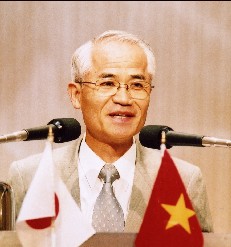Education at the School of Deaf and Mute
September 7th,2005
Principle of the Japan School of the Deaf and Mute
Mr.Akinobu Nishigai
 Principle Akinobu Nishigai of the Japan School of the Deaf and Mute was the guest speaker at the meeting of September 7:
Principle Akinobu Nishigai of the Japan School of the Deaf and Mute was the guest speaker at the meeting of September 7:
The Japan School for the Deaf and Mute is the only private institution for such handicapped children. We were founded in the same year as the Rotary Club of Tokyo and have celebrated our 85th Anniversary this year. It was the fruit of a Christian missionary, A.K. Reischauer��s efforts. He had two sons and a daughter. The daughter caught a fever from which her hearing was impaired. This gave impetus to the birth of this school.
That the former American Ambassador to Japan, E.O. Reischauer was his second son is well known.
Sign language comes to mind when we speak of deafness, but in our school we try to reactivate the ability to hear which still remains and our education is based on hearing.
In daily spoken language we speak a language which is filled with emotion, but this cannot be expressed by sign language. A person��s ear is fully mature 4 months after birth.
The baby is able to hear when the mother is pregnant, and shrinks when the parents shout in loud voices.
Thus children are not to be thought to grow up subject merely to education, but being made to realize that they are welcomed into this world and raised in a cheerful spirit.
We always say ��trust in the possibilities��. When the parents are informed that the newborn infant has difficulty in hearing, they receive a strong shock.
Children when born are not aware of their handicap. When they realize that their parents look at them sadly and do not call their names they think that they are to blame. It is being loved by one��s parents which forms the human base for the growing child. Even handicapped, you must believe in your child that he will grow and mature.
From my experience, the parents worry about 20 years in the future. The mother asks ��Will she be able to get married?�� I say ��Of cause, and be able to study too��.
The Japan seem unable to recognize a child��s merit in education. I would like to see the parents embrace their children saying ��We are so happy you were born to us��. We should believe in a child��s future.
In the human ear, there is the Eustachian tube resembling a snail which is a little larger than the size of a bean. When something is wrong with the haired cells there listening handicaps arise. In modern medicine, we have artificial inner ears.
By insertion of an electric pole in the Eustachian tube which stimulates the cells, hearing can be regained.
A normal person can hear sounds from 0 to 130 dB, and sounds over that becomes painful. By the use of hearing aids, although not a cure, hearing can be recovered.
To overcome deafness, we must conduct person to conversation to have the person experience the joy of conversing, of being understood while young.
At our school, we teach our children to look at the other person��s face and expression during the conversation.
There are 106 schools in Japan for hearing handicapped children, and we are the only private one. It is important that our education must start at a young age. We accept newly born babies who have been discovered to suffer from this handicap.
School starts at 8:45 a.m. and the halls are filled with children��s voices.
The first thing we do is to check their hearing aids, and see that their batteries are still functioning. Then, child��s ears are checked for inflammation.
In order to see that the hearing aid is working, we call each child��s name from behind to see their reaction. Each child in class also wears an infra red ray receiver to supplement their hearing aid.
In our kindergarten classes we have rhythm play until 2:45, then to cultivate creativity we engage in group topics or making songs. At the same time, we engage in individual lessons. In an ordinary school the children can be taught but children with a hearing handicap find it difficult to express themselves.
By using man-to-man teaching, we can draw out what interests the child most.
Hearing aids are developing, but are still quite inconvenient compared to the human ear. They pick up background noises and amplify them too.
It is difficult for them to just amplify human voices.
The child leads in our interaction process. The teacher draws out topics which interest the child and formulates it in conversational form. It fosters a feeling in the child that people are interested in what he has to say.
We also use picture books, picture diaries and photographs for tools but feel that it is important that we use daily conversation to foster the children��s minds, and have them believe that every thing can be overcome.
In the future, our children will become self sufficient by being able to use our daily language and make their contribution to society. We sincerely appreciate the support your club has been giving us and look forward to your continuing goodwill in the future.
(The Tokyo Rotary Club has supported the Japan School for the Deaf and Mute off and on for a number of years)